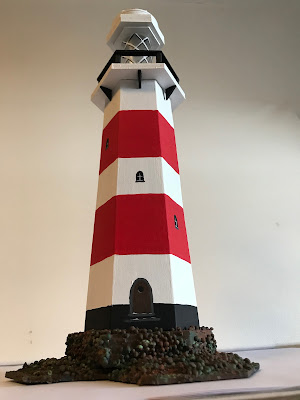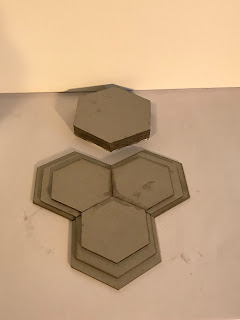We'll start with the tower. You'll need an empty cereal box, a hexagon with 3cm sides, and a hexagon with 4cm sides. My tower section is 20cm tall. Mark out the shape on the cardboard box (see diagram at the end - it's easier than trying to explain in words!).
Cut out the complete shape. I scored along the fold lines with an embossing tool and steel ruler, fold carefully and sharpen the folds with a bone folder.
I used a fast setting solvent glue for this bit. Starting next to the flap glue the larger hexagon in place with the first two sides - this will hold the hex better than trying to do just one side. Repeat with the smaller hex.
Allow the glue to set before you move on. Continue glueing just one side at a time until you come back to the flap. Glue the last side over the flap and hold until set. (Phew! that's the difficult bit done!)
I loosely stacked the shapes together to see what made an attractive shape before I started glueing.
Next was the platform with handrail.For this I glued three 4.5cm hexs together, topped with a 4cm hex. The hand rail is a 4cm frame. I found a bamboo stick from a plant pot label and cut six 1.5cm lengths for the uprights. Using solvent glue I arranged the uprights to support the handrail. When dry I glued this to the three larger hexs to form the platform. Arrange it so all the hexs are facing the same direction.
Later I found that the platform could do with being a little more stable so I cut some 1cmx1cm right angled triangles from greyboard sheets to help seat it on top of the tower.The lantern is a plastic miniature rum bottle (hic!), cut off at the shoulder (be careful when using sharp tools!). This is glued top and bottom to two 2.5cm hexs.
The canopy was built using five 3cm, three rings left over from Industrial Elements, one 2.5cm hex, three smaller rings from Industrial Elements, two washers, two large nuts, two small nuts, all leftover from Industrial elements. You can use whatever you have to make an attractive canopy.
The central base is made from three 5cm hexs and two 5cm frames. The base extensions are each of a 4.5cm, 4cm, and 3.5cm hex. These are arranged and glued as in the photograph to make a good stable base for the lighthouse.
Decoration:
The base was smeared with texture paste then large and small Art Stones were pressed in to the damp surface. This took more than 24 hours to set properly! When dry, with a stiff-ish brush, I dabbed a watery mix of Zinc all over to get in the nooks and crannies. Next came Burnt Umber dabbed randomly over the top, followed by Burnt Orange. Then to get the seaweedy slime look, some patches of Forest Green. The flat part of the base is Lamp Black.
The tower was gessoed first to cover as much of Kellogg's colours as possible (perhaps I should have used the plain side on the outside!) then at least two coats of Titanium White to get good coverage. I used True Red for the stripes, and Lamp Black for the damp proofing around the bottom. The door was added with Burnt Umber, outlined in Zinc. Zinc was used for the steps to the door. Windows are Lamp Black, Titanium White for the frames, Zinc for the window sills.
The platform is white with black handrails and supports and walking surface. I added a red band for fun. Underneath the supporting triangles are black.
The lantern has white plates top and bottom. I painted a white lattice pattern on the glass, with black shadows.
The canopy is white with one section in red and a red bit on the top.
This project used a whole set of hexs and leftovers from other kits. I measured the flat sides of my hexs. Use whatever you have to hand to make your lighthouse. Nobody with know what you have used once it has been painted!
(Diagram for tower:Thank you for visiting - if you get stuck please ask and I'll help.
Supplies:
Hexagons for Hex Tech Tuesdays
DecoArt Americana Colours, various
Texture Paste
Art Stones (optional)
Odds, sods, and leftover bits
















No comments:
Post a Comment